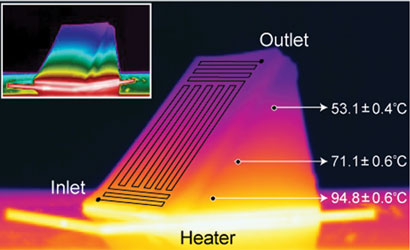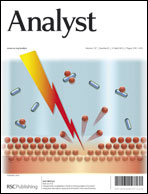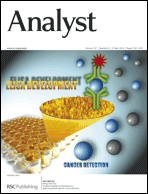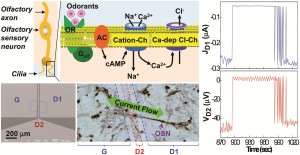
Real-time separation of natural products by ultrafast 2D NMR coupled to on-line HPLC
Luiz H. K. Queiroz Júnior, Darlene P. K. Queiroz, Liene Dhooghe, Antonio G. Ferreira and Patrick Giraudeau
Analyst, 2012, Advance Article
DOI: 10.1039/C2AN16208C

Real-time separation of natural products by ultrafast 2D NMR coupled to on-line HPLC
Luiz H. K. Queiroz Júnior, Darlene P. K. Queiroz, Liene Dhooghe, Antonio G. Ferreira and Patrick Giraudeau
Analyst, 2012, Advance Article
DOI: 10.1039/C2AN16208C

A height-dependent linear temperature gradient established on the inclined surface of a 3D qiandu (right triangular prism)-shaped PDMS microdevice enables flow-through PCR employing a single heater
South Korean scientists have created a temperature cycle for the on-chip flow-through polymerase chain reaction (PCR) using a single heater.
PCR is used to make copies of a piece of DNA for genetic research, disease analysis and diagnosis. It consists of four main steps – initialisation; denaturation (melting the DNA template to yield single-stranded DNA); annealing primers to the single-stranded DNA template; and extension, in which the DNA polymerase synthesises a new DNA strand complementary to the DNA template.
On-chip flow-through PCR typically has a short reaction time due to rapid thermal equilibrium allowing quick temperature transitions; however, it normally requires several separate heating blocks to create the different temperatures. Reducing the number of heaters will help make the whole system smaller and more portable. ‘Analysing samples on site could help prevent degradation and contamination,’ explains Nae Yoon Lee from Gachon University, South Korea, who led the research.
Read the full story here in Chemistry World.
Link to journal article:
Flow-through PCR on a 3D qiandu-shaped polydimethylsiloxane (PDMS) microdevice employing a single heater: toward microscale multiplex PCR
Wenming Wu, Kieu The Loan Trinh and Nae Yoon Lee
Analyst, 2012, Advance Article
DOI: 10.1039/C2AN35077G
It’s been a busy year already with so many great papers, so here are some HOT articles from Analyst that you might have missed this month!
Why not take a look, they will be free to read for 2 weeks.
 A hydrophobic entrance enhances ion current rectification and induces dewetting in asymmetric nanopores
A hydrophobic entrance enhances ion current rectification and induces dewetting in asymmetric nanopores
Matthew Pevarnik, Ken Healy, Matthew Davenport, Joseph Yen and Zuzanna S. Siwya
Analyst, 2012, Advance Article
DOI: 10.1039/C2AN16139G
Analytical investigation of salivary calculi, by mid-infrared spectroscopy
Jean-François Sabot, Marie-Paule Gustin, Katia Delahougue, Frédéric Faure, Christelle Machon and Daniel-Jean Hartmann
Analyst, 2012, Advance Article
DOI: 10.1039/C2AN15924D
Metal-based impurities in graphenes: application for electroanalysis
Sze Yin Chee and Martin Pumera
Analyst, 2012, Advance Article
DOI: 10.1039/C2AN00022A
Integration of gas chromatography mass spectrometry methods for differentiating ricin preparation methods
David S. Wunschel, Angela M. Melville, Christopher J. Ehrhardt, Heather A. Colburn, Kristin D. Victry, Kathryn C. Antolick, Jon H. Wahl and Karen L. Wahl
Analyst, 2012, Advance Article
DOI: 10.1039/C2AN16186A
A novel method for simultaneous analysis of three β2-agonists in foods with the use of a gold-nanoparticle modified glassy carbon electrode and chemometrics
Xiaoyun Lin, Yongnian Ni, Shuzhen Li and Serge Kokot
Analyst, 2012, Advance Article
DOI: 10.1039/C2AN16062E
Flow-through PCR on a 3D qiandu-shaped polydimethylsiloxane (PDMS) microdevice employing a single heater: toward microscale multiplex PCR
Wenming Wu, Kieu The Loan Trinh and Nae Yoon Lee
Analyst, 2012, Advance Article
DOI: 10.1039/C2AN35077G
 Electrochemiluminescent detection of Mucin 1 protein and MCF-7 cancer cells based on the resonance energy transfer
Electrochemiluminescent detection of Mucin 1 protein and MCF-7 cancer cells based on the resonance energy transfer
W. Wei, D. F. Li, X. H. Pan and S. Q. Liu
Analyst, 2012, Advance Article
DOI: 10.1039/C2AN35059A
Enhanced fluorescent chemosensor for Ag+ in absolute aqueous solution and living cells: An experimental and theoretical study
Mingming Hu, Jiangli Fan, Jianfang Cao, Kedong Song, Hua Zhang, Shiguo Sun and Xiaojun Peng
Analyst, 2012, Advance Article
DOI: 10.1039/C2AN16272E
Ultrasensitive electrochemiluminescence immunosensor using PtAg@carbon nanocrystals composites as labels and carbon nanotubes-chitosan/gold nanoparticles as enhancer
Meng Zhang, Weijian Dai, Mei Yan, Shenguang Ge, Jinghua Yu, Xianrang Song and Wei Xu
Analyst, 2012, Advance Article
DOI: 10.1039/C2AN35186B
A new continuous fluorometric assay for acetylcholinesterase activity and inhibitor screening with emissive core–shell silica particles containing tetraphenylethylene fluorophore
Xiang Shen, Fuxin Liang, Guanxin Zhang and Deqing Zhang
Analyst, 2012, Advance Article
DOI: 10.1039/C2AN35154D
Examining changes in cellular communication in neuroendocrine cells after noble metal nanoparticle exposure
Sara A. Love, Zhen Liu and Christy L. Haynes
Analyst, 2012, Advance Article
DOI: 10.1039/C2AN00034B
Noise Adjusted Principal Component reconstruction to optimize infrared microspectroscopy of individual live cells
Ellen J. (Swain) Marcsisin, Christina M. Uttero, Antonella I. Mazur, Miloš Miljković, Benjamin Bird and Max Diem
Analyst, 2012, Advance Article
DOI: 10.1039/C2AN15868J
Graphene oxide integrated sensor for electrochemical monitoring of mitomycin C–DNA interaction
Arzum Erdem, Mihrican Muti, Pagona Papakonstantinou, Ece Canavar, Hakan Karadeniz, Gulsah Congur and Surbhi Sharma
Analyst, 2012, Advance Article
DOI: 10.1039/C2AN16011K
Expression of membrane-associated proteins within single emulsion cell fascimiles
Mayuree Chanasakulniyom, Chiara Martino, David Paterson, Louise Horsfall, Susan Rosser and Jonathan M. Cooper
Analyst, 2012, Advance Article
DOI: 10.1039/C2AN35047E
A highly selective and sensitive enzyme-linked immunosorbent assay (ELISA) for the determination of the synthetic dye Para red in foodstuffs has been developed by Ting Xu, from the China Agriculture University, and colleagues. Para red is a dye that is used in printing, and is prohibited in foodstuffs due to it being a potential genotoxic carcinogen. The assay was tested on real food, and was comparable to current methods which are more resource intensive.
A sensitive and selective enzyme-linked immunosorbent assay for the analysis of para red in foods
Jia Wang, Keyi Wei, Hao Li, Qing X. Li, Ji Li and Ting Xu
Analyst , 2012, Advance Article
DOI : 10.1039/C2AN35127G
 Youngkyoo Kim from the Kyungpook National University, Republic of Korea, and colleagues have developed an artificial nose that can mimic the real thing! Olfactory sensory neurons from rats were cultured onto indium-tin oxide electrodes and direct voltage and current signals were then measured when it was exposed to odorants. It is hoped the present system can help advance the work in biomimetic artificial noses, which have a number of applications in medical diagnosis, anti-bioterror devices and environmental monitoring.
Youngkyoo Kim from the Kyungpook National University, Republic of Korea, and colleagues have developed an artificial nose that can mimic the real thing! Olfactory sensory neurons from rats were cultured onto indium-tin oxide electrodes and direct voltage and current signals were then measured when it was exposed to odorants. It is hoped the present system can help advance the work in biomimetic artificial noses, which have a number of applications in medical diagnosis, anti-bioterror devices and environmental monitoring.
Direct measurement of extracellular electrical signals from mammalian olfactory sensory neurons in planar triode devices
Hwajeong Kim, So Yeun Kim, Sungho Nam, Gabriele V. Ronnett, Hyung Soo Han, Cheil Moon and Youngkyoo Kim
Analyst , 2012, Advance Article
DOI : 10.1039/C2AN16205A
In this HOT article Xiu-Ping Yan and colleagues from Nankai University have developed a colourimetric method to determine the presence of histidine in urine. The method is detectable by the naked-eye, with an obvious colour change from yellow to purple. The detection of histidine, an amino acid found in many proteins, is used to help with the diagnosis of histidine metabolism disorders and other diseases such as epilepsy and Parkinson’s disease.
Take a look at their paper, it will be free to read for 2 weeks.
An indicator-displacement assay for naked-eye detection and quantification of histidine in human urine
Shao-Kai Sun, Kai-Xiong Tu and Xiu-Ping Yan
Analyst, 2012, Advance Article
DOI: 10.1039/C2AN35126A
The latest issue of Analyst features quite a few HOT articles for you to take a look at! Featuring logic gates, environmental monitoring, clinical analysis and analytical probes, there’s a little something for everyone.
Don’t forget you can browse the whole issue via the Analyst homepage.
Analysis of biomarkers characteristic of porcine liver injury—from biomolecular logic gates to an animal model
Lenka Halámková, Jan Halámek, Vera Bocharova , Steven Wolf, Kristine E. Mulier, Greg Beilman, Joseph Wang and Evgeny Katz
Analyst, 2012, 137, 1768-1770
DOI: 10.1039/C2AN00014H
A novel nanoaggregation detection technique of TNT using selective and ultrasensitive nanocurcumin as a probe
Alok Pandya, Heena Goswami, Anand Lodha and Shobhana K. Menon
Analyst, 2012, 137, 1771-1774
DOI: 10.1039/C2AN35131E
Coherent two-dimensional infrared spectroscopy: Quantitative analysis of protein secondary structure in solution
Carlos R. Baiz, Chunte Sam Peng, Mike E. Reppert, Kevin C. Jones and Andrei Tokmakoff
Analyst, 2012, 137, 1793-1799
DOI: 10.1039/C2AN16031E
Visual detection of copper(II) ions in blood samples by controlling the leaching of protein-capped gold nanoparticles
Yen-Fei Lee, Ting-Wei Deng, Wei-Jane Chiu, Tsao-Yen Wei, Prathik Roy and Chih-Ching Huang
Analyst, 2012, 137, 1800-1806
DOI: 10.1039/C2AN16270A
On-line solid phase extraction of humic acid from environmental water and monitoring with flow-through chemiluminescence
Jingya Qu, Hui Chen, Chao Lu, Zhihua Wang and Jin-Ming Lin
Analyst, 2012, 137, 1824-1830
DOI: 10.1039/C2AN16002A
Characterization of poly(3,4-ethylenedioxythiophene):tosylate conductive polymer microelectrodes for transmitter detection
Simon T. Larsen, Richard F. Vreeland, Michael L. Heien and Rafael Taboryski
Analyst, 2012, 137, 1831-1836
DOI: 10.1039/C2AN16288A
Two-photon fluorescent probe for cadmium imaging in cells
Yongyou Liu, Xiaohu Dong, Jian Sun, Cheng Zhong, Boheng Li, Ximeng You, Bifeng Liu and Zhihong Liu
Analyst, 2012, 137, 1837-1845
DOI: 10.1039/C2AN16254G
Polypyrrole hollow fiber for solid phase extraction
Tian Tian, Jianjun Deng, Zhuoying Xie, Yuanjin Zhao, Zhangqi Feng, Xuejun Kang and Zhongze Gu
Analyst, 2012, 137, 1846-1852
DOI: 10.1039/C2AN16266K
A chromo- and fluorogenic sensor for probing the cancer biomarker lysophosphatidic acid
Wenwen Zhao, Weimin Liu, Wenjun Zhang, Lintao Zeng, Zhiyuan Fan, Jiasheng Wu and Pengfei Wang
Analyst, 2012, 137, 1853-1859
DOI: 10.1039/C2AN16153B
A faster, more informative way to probe protein structures, which are vital to understanding protein function, has been devised by researchers in the US.
Proteins drive most biological processes but the majority of studies on them are performed under non-biological conditions where key dynamic effects can’t be captured. For example, crystallography uses solid state, and mass spectrometry is in the gas phase and can be denaturing.
This method, developed by Carlos Baiz from the Andrei Tokmakoff group at Massachusetts Institute of Technology, uses two-dimensional infrared spectroscopy, and offers ultrafast time resolution, and enables study in solution, which provides the potential to look at protein folding/unfolding pathways; this could considerably expand scientists’ understanding of the protein structure/function relationship.
Coherent two-dimensional infrared spectroscopy: Quantitative analysis of protein secondary structure in solution
Carlos R. Baiz, Chunte Sam Peng, Mike E. Reppert, Kevin C. Jones and Andrei Tokmakoff
Analyst, 2012, Advance Article
DOI: 10.1039/C2AN16031E
There are a few HOT Comms and papers we’d like to bring to your attention in the latest issue of Analyst.
Featuring fluorescence assays, nanoparticle-based methods, multivariate regression in analytical chemistry, and chromatography: we hope you’ll find something to interest you.
Don’t forget to browse Issue 7 via the Analyst homepage.
This HOT article from Professor Robert Dunn of Kansas University will be part of our upcoming ‘Single’ themed issue, Guest Edited by Henry S. White.
Fluorescence microscopy is one of the most widely used approaches for probing structural and dynamic attributes of both model and natural membranes, and single molecule fluorescence measurements have recently been used to probe the orientation of fluorescent lipid analogs doped into lipid films at trace levels.
Find out how Prof. Dunn has extended this work and read the full paper